Happy New Year, Conscientious Food Consumers!
We, the staff of Kitchen Confessions, would like to extend to you a virtual pat on the back for wasting less food at home during this historic past year. We know you did that because you’re reading this blog. And thanks, by the way!
You’re doing your part to address the ongoing and monumental problem of wasted food in the U.S. Unfortunately, there’s still much to be done.
Wasted food this past year totaled more than 40 million tons — about 219 pounds for every American!
Wasted Food = Wasted $$. As consumers, we wasted $5.6 billion in spending on food that was not eaten. Across all sectors (production, retail, and consumers) on a national scale, it represents a loss of $161 billion.
Thankfully, in 2015 the US Department of Agriculture (USDA) and the US Environmental Protection Agency (EPA) set a goal to reduce food waste by half by 2030. Oregon’s Governor Kate Brown, through the Department of Environmental Quality, has also committed our state to that goal.
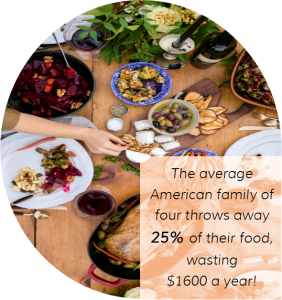
So we’re all for wasting less in 2021, aren’t we, Conscientious Food Consumers? In 2020, the Kitchen Confessions staff worked hard on our own wasteful habits around food. Please enjoy our Top Takeaways!
TAKEAWAY #1: More time in our own kitchens can mean less waste!
When we launched “Kitchen Confessions” last April, the COVID-19 pandemic had gotten real, and most of us were forced to shelter at home. As it turns out (and one of the hidden blessings of this pandemic), spending more time in our own kitchens has helped many of us become more conscious of our everyday food habits!
We’ve learned more about proper food storage techniques — using tools like the A-Z Fruit and Vegetable Storage Guide and the FDA’s Freezer Storage Chart and FoodKeeper app.
We’ve taken stock of what’s on hand and diligently done our record keeping of what’s in the fridge, freezer and pantry — using Smart Strategies like NFLB’s Freezer Inventory and Smart Shopping List. These are available in English and Spanish.
In that process, we’ve potentially wasted less of our planet’s precious resources, and saved more of our food dollars. Let’s keep it up!
TAKEAWAY #2: Telling the truth to ourselves about how food gets wasted is a good thing.
Like we’ve done with our Kitchen Confessions this past year, you’ve become more observant about how once-edible food ended up in the compost bin or garbage can. But if you haven’t already done so, you can take your truth-telling to the next level with our downloadable DIY Wasted Food Discovery Week self-survey.
It’s not about guilt-tripping — just the bottom line. After this exercise, you may be amazed how much MORE you have to work with in your grocery budget in 2021, and how much LESS food goes to waste!
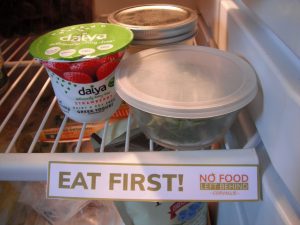
TAKEAWAY #3: E.F.A.M. saves $$! (Karen’s Waste-Less Resolution)
That stands for Eat First Area(s) Management. Those handy little signs (like the one shown) are available in English and Spanish and they help. But I’ve realized the most important thing for me is keeping up with my new habits in the kitchen.
I’ve certainly had my share of guilt trips this past year, making public Kitchen Confessions! When I added up the $$ wasted from items described in this blog, it was nearly $100, and that doesn’t cover everything I wasted last year.
But that wasted $$ has been useful for motivating positive changes in my own kitchen. So more E.F.A.M. in my fridge and pantry in 2021!
TAKEAWAY #4: Labeling, Labeling, Labeling! (Jeanette’s Waste-Less Resolution)
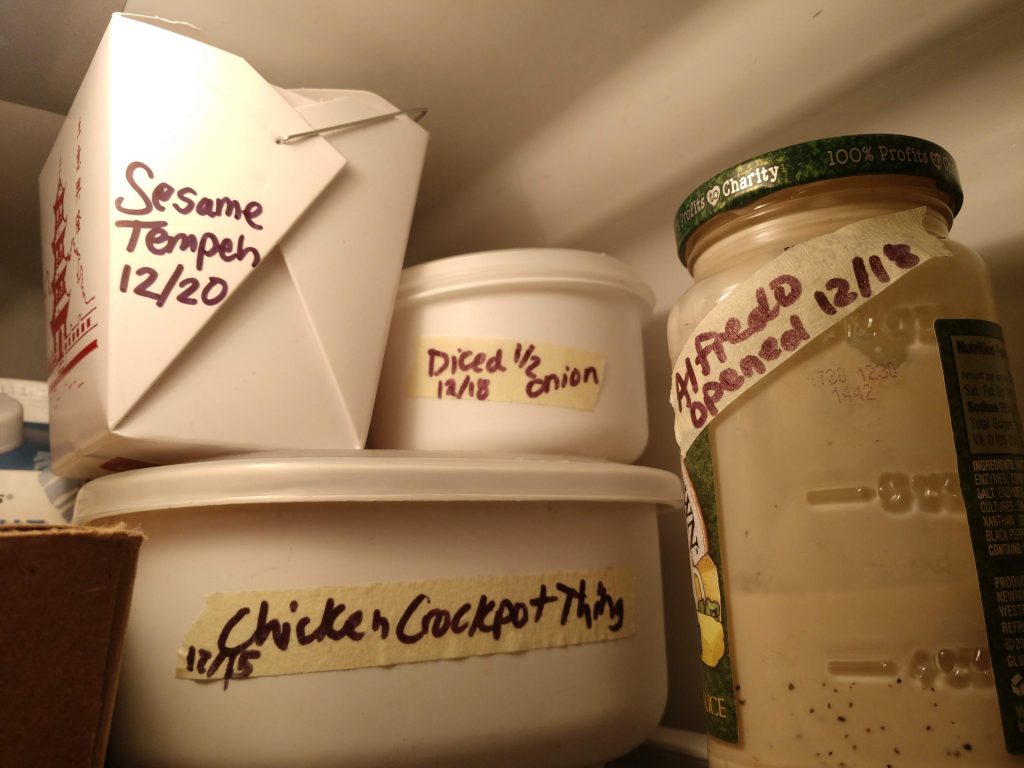
Marking the date food was prepped, opened, cooked or became leftovers… this new habit has been super helpful, before adding something to our Eat First! shelf. I also learned it works infinitely better in our fridge to label the front of those containers, not the top!
I also concur with Karen and plan to make a habit of maintenance – it’s key! It’s way too easy for things to get buried, so, frequent check-ins with the shelf mean low-to-no waste.
TAKEAWAY #5: It can be fun figuring out what to do with those items on your “Eat First” shelf!
If you’re like us, you’ve found some new mojo in “leftover land.” You’ve whipped up some creative meals with those random leftovers and what-have-you items using your own inspiration, BigOven.com, or your favorite app.
Maybe your kids have even gotten into the spirit of “Freezer Fridays,” making Eat First rollups, or learning to stew up some of their own leftovers in a crockpot. Maybe you decided to start making your own bone or veggie broth with that rotisserie chicken bones and/or beet greens and carrot/celery tops!
Jeanette’s Joy of Cooking moment: I made some great soup stock out of a batch of soy/butter/garlic water left over from steaming organic broccoli, and my husband raved about it!
For continued inspiration during 2021, check out these great recipes for leftovers and zero kitchen waste from SaveTheFood.com.

TAKEAWAY #6: Those “best by/use by” labels on food packaging aren’t the final word.
As explained in our “Check before you chuck it” blog, even if it’s past its packing date or lost its “shop appeal,” it’s likely to still be edible and safe. Fave relevant resources: StillTasty.com and the USDA’s FoodKeeper app.
TAKEAWAY #7: Old-fashioned methods of food preservation and storage are back in style.
Interest in home canning and preservation surged during the first months of the pandemic, and has continued.
Kitchen Confessions often refers to the OSU Extension Service for everything related to food safety and preservation. Another valuable Extension Service resource for introducing kids to nutrition, good habits in the kitchen and easy recipes is FoodHero.org.
TAKEAWAY #8: Meal portions are key to wasting less.
And thanks to tools like “the Guestimator” from Savethefood.com, there’s no more “guesswork”! We featured it in one of our Thanksgiving blogs as the holiday food season got rolling — but it’s handy for regular meal planning year round, not just when you anticipate having guests at the table. Which will hopefully be back in 2021!
THE BIGGER PICTURE: You, Conscientious Food Consumer and Shopper, are part of a national and global movement!
There’s an amazing array of research and resources underpinning the food waste reduction movement in the U.S., particularly in the nonprofit ReFED’s landmark 2016 analysis: the Roadmap to Reduce U.S. Food Waste.
 In 2017, Project Drawdown named reduced wasted food as its number three existing solution for reducing greenhouse gases and addressing the global climate change crisis.
In 2017, Project Drawdown named reduced wasted food as its number three existing solution for reducing greenhouse gases and addressing the global climate change crisis.
We’re also following LoveFoodHateWaste in the U.K., where the first-ever national Food Waste Action Week is happening in early March 2021.
Thanks again to all of you who have discovered, followed, and perhaps even recommended our blog during the past year. You can also share Kitchen Confessions through our Facebook page, “NFLBCorvallis.”
Here’s to a better and less wasteful 2021 for all!
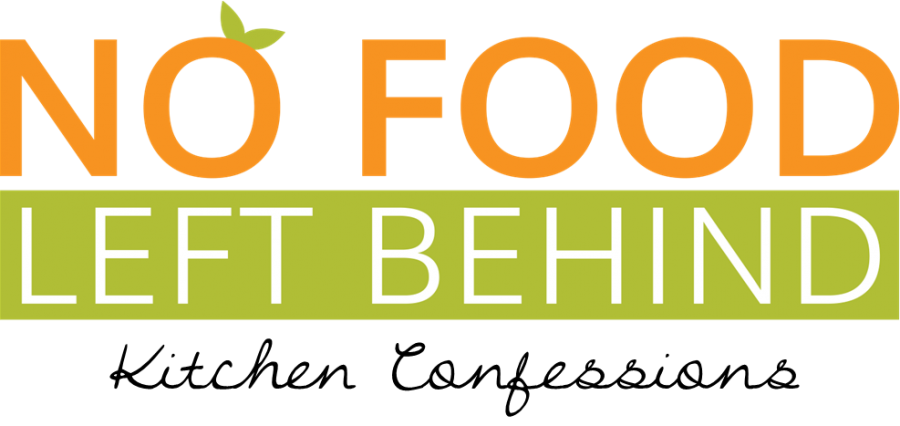

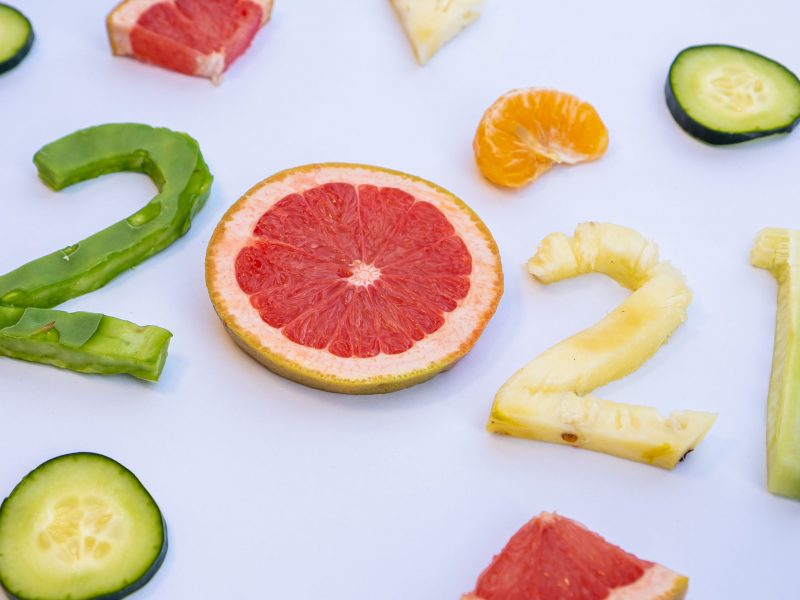
 Smart shopping and $aving — not just for the holidays!
Smart shopping and $aving — not just for the holidays!